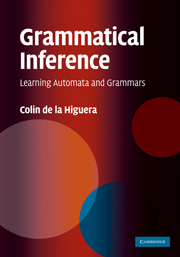Book contents
- Frontmatter
- Contents
- Preface
- Acknowledgements
- 1 Introduction
- 2 The data and some applications
- Part I The Tools
- Part II What Does Learning a Language Mean?
- Part III Learning Algorithms and Techniques
- 11 Text learners
- 12 Informed learners
- 13 Learning with queries
- 14 Artificial intelligence techniques
- 15 Learning context-free grammars
- 16 Learning probabilistic finite automata
- 17 Estimating the probabilities
- 18 Learning transducers
- 19 A very small conclusion
- References
- Index
18 - Learning transducers
from Part III - Learning Algorithms and Techniques
Published online by Cambridge University Press: 05 July 2014
- Frontmatter
- Contents
- Preface
- Acknowledgements
- 1 Introduction
- 2 The data and some applications
- Part I The Tools
- Part II What Does Learning a Language Mean?
- Part III Learning Algorithms and Techniques
- 11 Text learners
- 12 Informed learners
- 13 Learning with queries
- 14 Artificial intelligence techniques
- 15 Learning context-free grammars
- 16 Learning probabilistic finite automata
- 17 Estimating the probabilities
- 18 Learning transducers
- 19 A very small conclusion
- References
- Index
Summary
Pulpo a Feira, Octopus at a party
Anonymous, From a menu in O Grove, GaliciaDie Mathematiker sind eine Art Franzosen: Redet man zu ihnen, so übersetzen sie es in ihre Sprache, und dann ist es alsbald etwas anderes.
Johann Wolfgang von Goethe, Maximen und ReflexionenBilanguages
There are many cases where the function one wants to learn doesn't just associate a label or a probability with a given string, but should be able to return another string, perhaps even written using another alphabet. This is the case in translation, of course, between two ‘natural’ languages, but also of situations where the syntax of a text is used to extract some semantics. And it can be the situation in many other tasks where machine or human languages intervene.
There are a number of books and articles dealing with machine translation, but we will only deal here with a very simplified setting consistent with the types of finite state machines used in the previous chapters; more complex translation models based on context-free or lexicalised grammars are beyond the scope of this book.
The goal is therefore to infer special finite transducers, those representing subsequential functions.
Rational transducers
Even if in natural language translation tasks the alphabet is often the same for the two languages, this needs not be so. For the sake of generality, we will therefore manipulate two alphabets, typically denoted by Σ for the input alphabet and Γ for the output one.
Information
- Type
- Chapter
- Information
- Grammatical InferenceLearning Automata and Grammars, pp. 372 - 390Publisher: Cambridge University PressPrint publication year: 2010
